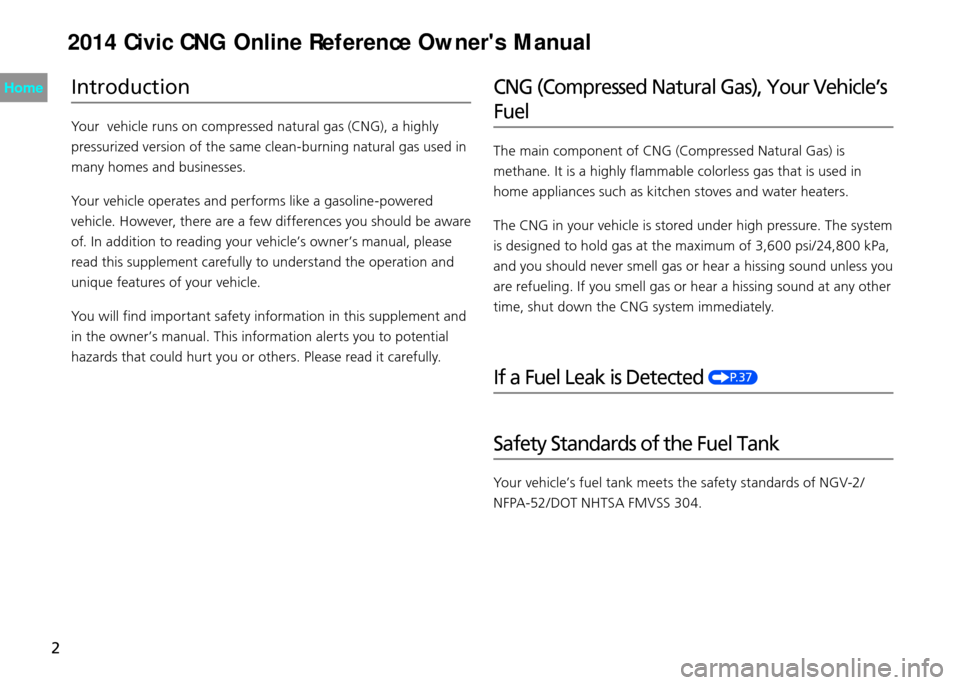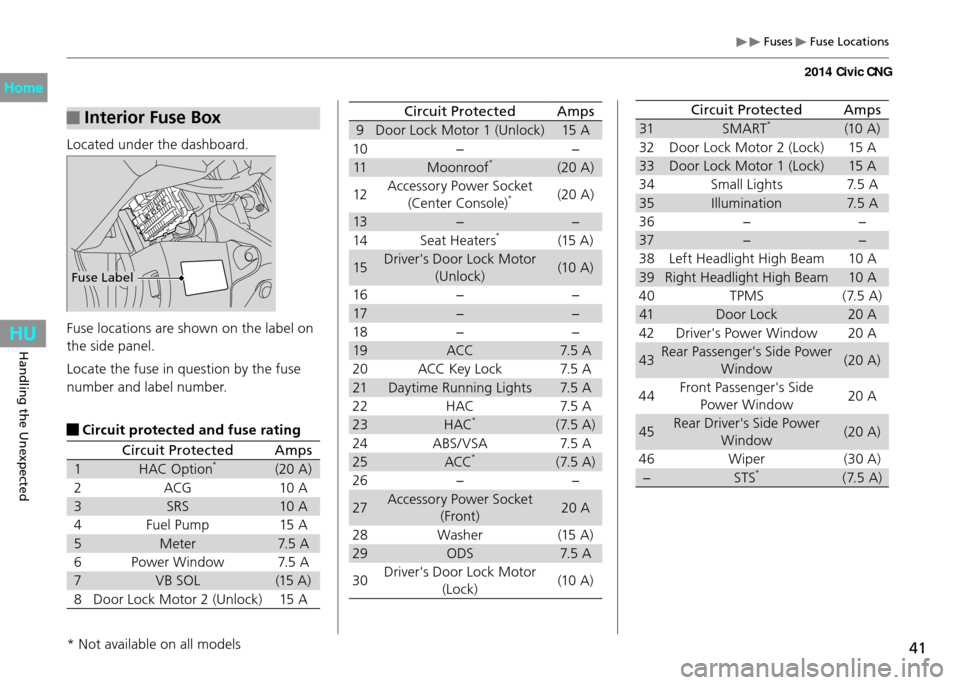Page 3 of 46

Introduction
Your vehicle runs on compressed natural gas (CNG), a highly
pressurized version of the same clean-burning natural gas used in
many homes and businesses.
Your vehicle operates and performs like a gasoline-powered
vehicle. However, there are a few differences you should be aware
of. In addition to reading your vehicle’s owner’s manual, please
read this supplement carefully to understand the operation and
unique features of your vehicle.
You will find important safety information in this supplement and
in the owner’s manual. This information alerts you to potential
hazards that could hurt you or others. Please read it carefully.
CNG (Compressed Natural Gas), Your Vehicle’s
Fuel
The main component of CNG (Compressed Natural Gas) is
methane. It is a highly flammable colorless gas that is used in
home appliances such as kitchen stoves and water heaters.
The CNG in your vehicle is stored under high pressure. The system
is designed to hold gas at the maximum of 3,600 psi/24,800 kPa,
and you should never smell gas or hear a hissing sound unless you
are refueling. If you smell gas or hear a hissing sound at any other
time, shut down the CNG system immediately.
If a Fuel Leak is Detected P.37
Safety Standards of the Fuel Tank
Your vehicle’s fuel tank meets the safety standards of NGV- 2/
NFPA-52/DOT NHTSA FMVSS 304.
22014 Civic CNG Online Reference Owner's Manual
Page 12 of 46

11
When Driving
Continued
Driving
Starting the Engine
Starting the Engine
Keep your foot firmly on the brake pedal when
starting the engine.
The engine is harder to start in cold weather and
in thinner air found at altitudes above 8,000 feet
(2,400 meters).
When starting the engine in cold weather, turn
off all electrical accessories (the lights, heating
and cooling system, and rear defogger) in order to
reduce battery drain.
If you live in a region where winter is extremely
cold, an engine block heater will improve starting
and warming of the engine. If temperatures
consistently below -22°F (-30°C) are expected, the
coolant mixture should be changed to a higher
concentration to prevent freezing. Consult a dealer
for details.
If the exhaust system sounds abnormal or you
can smell exhaust gas inside the vehicle, have
your vehicle checked by a dealer. There may be a
problem with the engine or exhaust system.
Brake Pedal
1. Make sure the parking brake is applied.
2. Check that the shift lever is in P
, then
depress the brake pedal.
Although it is possible to start the vehicle
in
N, it is safer to start it in P.
2014 Civic CNG
Page 42 of 46

41
Handling the Unexpected
Fuses Fuse Locations
Interior Fuse BoxCircuit ProtectedAmps
9 Door Lock Motor 1 (Unlock) 15 A
10 − −
11 Moonroof
*(20 A)
12 Accessory Power Socket
(Center Console)
*(20 A)
13 − −
14 Seat Heaters
*(15 A)
15 Driver's Door Lock Motor
(Unlock) (10 A)
16 − −
17 − −
18 − −
19 ACC 7.5 A
20 ACC Key Lock 7.5 A
21 Daytime Running Lights 7.5 A
22 HAC 7.5 A
23 HAC
*(7.5 A)
24 ABS/ VSA 7.5 A
25 ACC
*(7.5 A)
26 − −
27 Accessory Power Socket
(Front) 20 A
28 Washer (15 A)
29 ODS 7.5 A
30 Driver's Door Lock Motor
(Lock) (10 A)
Circuit Protected
Amps
31 SMART*(10 A)
32 Door Lock Motor 2 (Lock) 15 A
33 Door Lock Motor 1 (Lock) 15 A
34 Small Lights 7.5 A
35 Illumination 7.5 A
36 − −
37 − −
38 Left Headlight High Beam 10 A
39 Right Headlight High Beam 10 A
40 TPMS (7.5 A)
41 Door Lock 20 A
42 Driver's Power Window 20 A
43 Rear Passenger's Side Power
Window (20 A)
44 Front Passenger's Side
Power Window 20 A
45 Rear Driver's Side Power
Window (20 A)
46 Wiper (30 A)
− STS
*(7.5 A)
Located under the dashboard.
Fuse locations are shown on the label on
the side panel.
Locate the fuse in question by the fuse
number and label number.
Circuit protected and fuse rating
Circuit Protected
Amps
1 HAC Option*(20 A)
2 ACG 10 A
3 SRS 10 A
4 Fuel Pump 15 A
5 Meter 7.5 A
6 Power Window 7.5 A
7 VB SOL (15 A)
8 Door Lock Motor 2 (Unlock) 15 A
* Not available on all models
Fuse Label
2014 Civic CNG